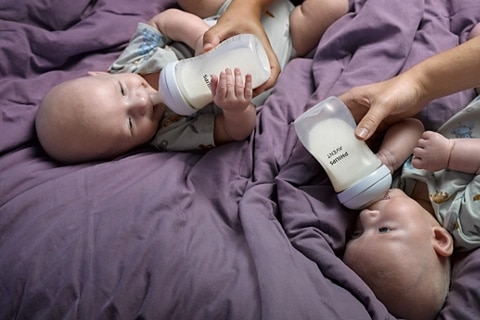
A guide to the best baby bottles to buy

In the blink of an eye, your pregnancy is over and you’re in charge of your little human. There are so many new things to consider as a parent, and life can be quite daunting when you start on your newborn journey. However, it doesn’t have to be! We’re here to help give you the low down on everything parent and child care, and today we’re going to walk you through paced bottle-feeding including: So, whether you are combination feeding, formula feeding, or even expressing breastmilk for the occasional bottle, read on to explore our guide to pace feeding a newborn.
To be able to start using this method, it’s important to understand what paced feeding is:
Next, let’s explore the benefits of paced bottle-feeding:
Bottle-feeding can often lead to the bypassing of cues that a baby is full, especially as you more closely monitor the amount your baby has consumed. Pace feeding with a bottle can help prevent pressuring your baby into over-feeding and reduce the risk of rapid weight gain and obesity.1
How your baby feeds can contribute to discomfort in the form of problems such as gas, colic,2 and reflux.3 Paced bottle-feeding reduces the risk of air intake when feeding, therefore reducing the risk of discomfort.
Top tip: Invest in the best product for your baby, such as the Philips Avent Natural Response with AirFree vent bottles. This range is designed to ease common feeding issues like colic, gas, and reflux. With the innovative AirFree vent, they ensure the teat stays filled with milk, not air, promoting upright feeding in various positions for your little one. Be sure to check out our video for a demonstration of assembling this bottle range!
Pace feeding with a bottle makes the transition from breast to bottle and bottle to breast much easier for breastfed babies. If you allow your baby to gulp down a bottle it could confuse them when returning to breastfeeding as the flow rate is slower and more regulated.
Top tip: For more information, discover everything you need to know about combining breastfeeding and bottle feeding in our simple guide.
Pace-feeding a newborn is beneficial for several reasons, and if you want to get started, we’ll show you how. Simply follow these steps to prepare for paced feeding:
From formula to breastmilk, choosing the right bottle for your baby’s feed is essential. Don’t forget that newborn paced feeding will be different to feeding a toddler, so choose the right size for your child.
Top tip: The Philips Avent Natural Response baby bottles are a great choice of BPA-free, anti-colic bottles that mimic the shape of the breast with a soft and flexible teat ideal for paced bottle-feeding. The ergonomic bottle is perfect for little hands to hold it, too!
The teat determines how quickly milk flows from the bottle, so choosing the correct one is paramount for successful pace feeding with a bottle.
Top tip: From first flow to fast flow, Philips offers a diverse range of teats suitable for use with their Natural Response bottles, making a customisable bottle-feeding experience possible from newborns to infants over 6 months. For help choosing the right teat for your baby, we’ve created a simple guide.
Sterilising the bottles and teats will help to prevent your baby becoming ill. Warm milk is an ideal breeding ground for bacteria. Sterilising will kill most of these bacteria and protect your baby from food poisoning, vomiting, and diarrhoea.4
Top tip: Sterilising your equipment is a key step in protecting your baby and preparing for paced feeding. For more information, we have created a helpful guide to sterilising.
For any successful feed, you and your baby should be comfortable. This is even more important for paced bottle feeding which can take a little longer. For paced feeding, the ideal position for your baby is upright, with their head and neck properly supported.
So, how long should paced bottle feeding take, and how exactly do you introduce this feeding method to your baby’s routine? Here’s our step-by-step guide for how to pace bottle feed: Top tip: Whether you’re at home or on the go, Philips Avent Natural Response bottles are silicone, making them the perfect companion. However, even with the right bottle your baby can be fussy. Check out our tips if you’re wondering what to do when your baby is refusing the bottle. With that, you have a comprehensive guide to how to pace feed, with all the information you need to make an informed decision about this method. Whether you want to know what paced bottle-feeding is, what the benefits are, or simply how to do it, we’ve got you covered. Paced feeding is great for parents, whether you’re feeding your baby breastmilk, formula, or a combination of the two. If you’re choosing to express and want more information, why not read our guide to how often you should use a breast pump?